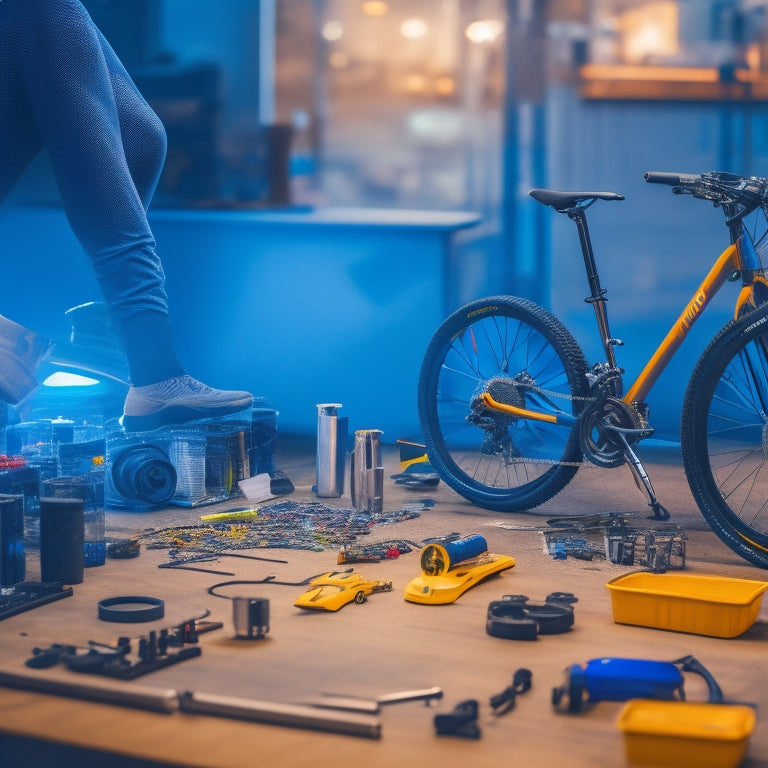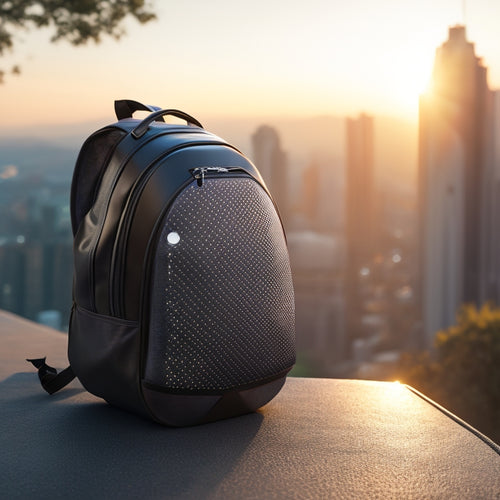
10 Best Electric Bike Conversion Kit Installation Prices
Share
You're looking to convert your bike into an e-bike, and you want to know the costs involved. Front hub motor kit installation prices start at around $200, while rear hub motor kits begin at $300. Mid drive motor kits, ideal for hills and heavy loads, range from $500 to $1,000. Throttle-assisted kits cost between $100 and $300, while pedal-assisted kits start at $200. Multi-speed, fat tire, and commuter bike kit prices vary, but expect to pay $200 to $1,500. High-speed kits can cost upwards of $2,000. To get the best deal, consider the complexity of your install, labor rates, and kit specifications - and take the next step to explore the options that fit your needs.
Key Takeaways
• Installation costs vary depending on kit specifications, labor rates, and complexity of wire routing and component integration.
• High-speed kits offer a thrilling riding experience, but compliance with speed regulations and expert installation are crucial.
• Conversion kit prices range from affordable single-speed options to high-end mid-drive motor kits with advanced features.
• Factors affecting installation costs include tool requirements, technical skills, physical demands, and workspace considerations.
• Expert installation is essential to ensure safe and optimal performance, regardless of the chosen kit and bike type.
Front Hub Motor Kit Installation
When installing a front hub motor kit, you'll need to prepare your bike by removing the front wheel. This will grant you clear access to the dropouts and brake caliper. Next, verify your wheel alignment is precise, as any misalignment can cause uneven tire wear and affect the overall performance of your e-bike.
Take this opportunity to inspect your brake caliper and confirm its compatibility with the new motor kit. You'll want to make sure the brake caliper clears the motor's axle and doesn't interfere with the motor's rotation.
Once you've confirmed brake compatibility, you can begin installing the motor kit. Start by attaching the motor to the dropouts, making sure it's securely fastened. Then, connect the motor wires to the controller and battery. Be meticulous when routing the cables to avoid any pinching or chafing.
Rear Hub Motor Kit Installation
You'll need to remove the rear wheel to access the dropouts and brake caliper, guaranteeing a smooth installation of the rear hub motor kit. This is an essential step, as it allows you to properly align the hub motor with the dropouts. Improper alignment can lead to poor performance, uneven wear on the tire, and even damage to the motor.
To guarantee a successful installation, follow these steps:
-
Remove the rear wheel: Take off the nuts or quick-release lever to remove the wheel from the dropouts.
-
Inspect the dropouts: Clean and inspect the dropouts for any debris or corrosion that may affect the motor's alignment.
-
Align the hub motor: Carefully align the hub motor with the dropouts, ensuring it's centered and secure.
- Reinstall the rear wheel: Once the motor is properly aligned, reinstall the rear wheel, making sure it's securely fastened.
Remember to double-check your work to ensure a smooth and efficient ride. Proper installation of the rear hub motor kit will give you the performance and reliability you need to enjoy your electric bike.
Mid Drive Motor Kit Installation
When considering a mid-drive motor kit installation, you'll need to decide on the type of motor that suits your needs, such as a geared or gearless option.
You'll also need to think about the motor's power and torque output, which will impact the bike's performance and your riding experience.
As you prepare for the installation, be aware that the process can be more complex and time-consuming compared to other types of kits.
Mid Drive Motor Options
Your mid drive motor kit installation options depend on the type of bike you're converting, with popular choices including the Bafang BBS02 and BBSHD, as well as the Tongsheng TSDZ2 and TDCM. When selecting a mid drive motor, contemplate the benefits of a more balanced weight distribution, improved hill-climbing ability, and enhanced overall performance.
Here are some key factors to keep in mind when choosing a mid drive motor:
-
Motor durability: Look for motors with a proven track record of reliability and long lifespan.
-
Gear ratio: Ensure the motor's gear ratio is compatible with your bike's gearing system.
-
Power output: Choose a motor that provides the right amount of power for your riding style and terrain.
- Installation complexity: Ponder the level of difficulty involved in installing the motor, as well as any additional components required.
Motor Power and Torque
Determining the ideal motor power and torque for your mid drive motor kit installation involves calculating your specific requirements based on factors such as rider weight, terrain, and desired speed. You'll want to take into account the type of riding you'll be doing most often, as well as the weight and aerodynamics of your bike. For example, if you're a heavier rider or plan to tackle steep hills, you'll need more power and torque to maintain a comfortable pace.
Motor efficiency also plays an essential role in determining the ideal power and torque for your mid drive motor kit. Look for a motor with a high efficiency rating, as this will maximize your battery life and overall performance. Power curves will also give you an idea of a motor's performance capabilities, so be sure to review these when selecting your motor.
Installation Difficulty Level
The complexity of mid drive motor kit installation can be broken down into several key factors. These include the type of bike you're working with, your level of mechanical aptitude, and the specific components included in your kit.
As you prepare for the installation process, it's essential to assess your DIY friendliness and electric expertise to ensure a smooth experience.
Here are some key considerations to keep in mind:
-
Tool requirements: Do you have the necessary tools, such as a torque wrench and wire strippers, to complete the installation?
-
Technical skills: Are you comfortable with basic electrical connections and mechanical assemblies?
-
Physical demands: Are you prepared to lift and maneuver the bike, as well as work in potentially cramped spaces?
- Workspace needs: Do you have a dedicated workspace with adequate lighting, ventilation, and safety precautions?
Throttle-Assisted Kit Installation Cost
On average, installing a throttle-assisted kit can cost you between $300 and $1,500, depending on the complexity of the conversion and the professional's expertise. This type of kit is ideal for urban commuting, as it provides a boost of power when you need it, making it perfect for moving through heavy traffic.
When choosing a throttle-assisted kit, consider your rider profile and the bike maintenance you're willing to perform. If you're a casual rider, a basic kit might suffice, but if you're an avid cyclist, you may want to invest in a more advanced kit with a longer battery life.
Here's a breakdown of the costs associated with throttle-assisted kits:
| Kit Type | Cost | Features |
| Basic | $300-$800 | Limited battery life, basic components |
| Mid-Range | $800-$1,200 | Extended battery life, upgraded components |
| Advanced | $1,200-$1,500 | Long battery life, high-performance components, warranty options |
Keep in mind that road safety is important, so be sure to choose a kit that meets your local regulations. Additionally, consider the warranty options and battery life when making your decision.
Pedal-Assisted Kit Installation Price
When you decide on a pedal-assisted kit installation, you'll need to take into account the cost of the front hub motor. This component can range from $200 to $500, depending on the quality and brand.
Additionally, you'll need to factor in the cost of converting your rear wheel, which can add another $100 to $300 to the total bill.
As you plan your installation, it's crucial to weigh these costs against the benefits of a pedal-assisted system.
Front Hub Motor Cost
You'll typically pay between $200 and $500 for a front hub motor, which is an essential component of a pedal-assisted kit installation. This cost variation depends on factors like motor efficiency, hub design, and brand reputation.
Here are some key considerations that affect the price of a front hub motor:
-
Motor Efficiency: A more efficient motor means more power and longer battery life, which can increase the cost.
-
Hub Design: The design of the hub motor, including the type of bearings and axle, can impact the price.
-
Brand Reputation: Established brands with a reputation for quality and reliability often charge more for their products.
- Additional Features: Some front hub motors come with additional features like regenerative braking or advanced sensors, which can increase the cost.
When choosing a front hub motor, consider your specific needs and priorities. If you're looking for a high-performance motor with advanced features, be prepared to pay a premium. However, if you're on a budget, there are more affordable options available that still offer reliable performance.
Rear Wheel Conversion
Your pedal-assisted kit installation will likely require a rear wheel conversion, which can cost between $300 and $600, depending on the complexity of the installation and the quality of the components used. This process involves replacing your existing rear wheel with a custom-designed wheel that integrates the electric motor.
The wheel design will be tailored to your specific bike's geometry and your riding style. During the conversion process, the installation expert will carefully select a wheel size that guarantees a smooth, efficient ride. This might involve adjusting the gear ratios to optimize power distribution or modifying the brake system to accommodate the added weight and speed of the e-bike.
The conversion benefits are well worth the investment, as you'll enjoy improved acceleration, increased range, and a more comfortable ride.
Single-Speed Kit Installation Prices
Converting your bike to a single-speed electric bike using a conversion kit can cost between $300 and $800, depending on the kit's quality, features, and the complexity of the installation process. One of the significant advantages of single-speed kits is their ease of installation, which reduces labor costs. You can expect to pay around $100 to $300 for a professional installation, depending on your location and the installer's rates.
Here are some benefits you can expect from a single-speed kit:
-
Simplified Gear System: With a single-speed kit, you won't have to worry about complex gear systems or derailleurs.
-
Lighter Weight: Single-speed kits are often lighter than multi-speed kits, making your bike more agile and easier to maneuver.
-
Lower Maintenance: With fewer components, single-speed kits require less maintenance and are less prone to mechanical issues.
- Cost-Effective: Single-speed kits are generally more affordable than multi-speed kits, making them an excellent option for those on a budget.
Multi-Speed Kit Installation Cost
When upgrading to a multi-speed electric bike using a conversion kit, your total cost will likely range from $800 to $1,500, depending on the kit's quality, features, and the complexity of the installation process. This price range includes the cost of the kit itself, labor costs, and any additional components you may need.
| Kit Type | Speeds | Price Range |
|---|---|---|
| Shimano Nexus | 3-7 | $800-$1,200 |
| SRAM i-Motion | 3-9 | $900-$1,300 |
| Bosch Active Line | 3-9 | $1,000-$1,500 |
When choosing a multi-speed kit, consider using a Speed Calculator to determine the ideal gear ratio for your riding style. This will secure a smooth and efficient ride. Additionally, consider a Kit Comparison to find the best value for your budget. With a multi-speed kit, you'll enjoy a more dynamic riding experience, tackling various terrains with ease.
Fat Tire Kit Installation Prices
Fat tire electric bike conversion kits, designed for off-road adventures and heavy-duty use, typically cost between $1,200 and $2,500, including the kit itself, labor costs, and any additional components. These kits are perfect for winter riding in snowy terrain, allowing you to tackle challenging trails with confidence.
When you decide on a fat tire kit, you'll need to take into account the following factors that impact the installation price:
-
Motor power: A more powerful motor will increase the overall cost, with prices ranging from $800 to $1,800.
-
Battery type and capacity: The type and capacity of the battery will influence the cost, with high-capacity batteries costing between $500 to $1,000.
-
Additional components: Incorporating features like suspension forks, hydraulic brakes, or custom wheels will add to the overall cost, ranging from $200 to $800.
- Labor costs: The complexity of the installation and the mechanic's expertise will affect labor costs, which can range from $200 to $500.
When you're ready for an off-road adventure, a fat bike conversion kit is an excellent choice. With the right components and expert installation, you'll be prepared to tackle any snowy terrain that comes your way.
Commuter Bike Kit Installation Cost
When considering a commuter bike kit installation, you'll want to factor in the cost of compatibility checks, as not all commuter bikes are suitable for electric conversion.
The labor cost will also vary depending on the complexity of the wiring and the technician's expertise. Additionally, the wiring complexity itself can greatly impact the overall installation cost, so it's crucial to assess these factors carefully.
Bike Type Compatibility
You can install a commuter bike kit on various bike types, but the installation cost will vary depending on your bike's frame material, wheel size, and brakes. The type of bike you have will have a big impact on the installation process and cost.
Here are some bike types that can be compatible with commuter bike kits:
-
Mountain bikes: With sturdy frames and wide tires, mountain bikes can be a great choice for electric conversion.
-
Hybrid models: These bikes combine the comfort of-road bikes with the versatility of mountain bikes, making them a great choice for commuting.
-
Cruiser frames: Cruiser bikes are designed for comfort and style, making them a great match for electric conversion.
- Folding designs: Folding bikes are perfect for commuters who need a bike that can be easily stored and transported.
Keep in mind that vintage restorations and electric hybrids may require more complex installations, which can raise the cost. It's important to take into account your bike's specifications before selecting a commuter bike kit to ensure a smooth and cost-effective installation process.
Labor Cost Factors
The labor cost of installing a commuter bike kit can vary greatly depending on the technician's expertise, workshop rates, and the complexity of the installation process. As you consider getting your bike converted, you'll want to factor in the labor costs, which can range from $50 to $200 per hour, depending on the technician's work experience.
Labor unions, like the National Bicycle Dealers Association, often set standards for labor rates, but individual workshops may charge more or less depending on their overhead costs and target profit margins. A technician with extensive work experience in electric bike conversions will likely charge a higher rate than someone with less experience.
Additionally, the complexity of the installation process will also impact labor costs. For instance, if your bike requires custom modifications or has unique components, the technician may need to spend more time figuring out the best approach, which increases the labor cost.
Be sure to ask your technician about their work experience and the estimated labor cost before committing to the installation.
Wiring Complexity
As you explore the installation process, the wiring complexity of your commuter bike kit plays a substantial role in determining the overall cost, with intricate electrical systems requiring more time and expertise to integrate seamlessly with your bike's existing components.
The complexity of the wiring system can have a notable impact on the installation cost. Here are some key factors to take into account:
-
Circuit Design: A well-designed circuit is essential for efficient and safe operation. A more intricate circuit design requires more time and expertise, increasing the installation cost.
-
Wire Routing: The routing of wires and cables can be time-consuming, especially in tight spaces. More elaborate wire routing requires more labor hours, adding to the overall cost.
-
Component Integration: The integration of components, such as the motor, battery, and controller, requires careful planning and execution. More intricate integrations demand more expertise and time, increasing the cost.
- Troubleshooting: Debugging and troubleshooting complex wiring issues can be a time-consuming process, adding to the overall installation cost.
High-Speed Kit Installation Prices
Converting your bike to a high-speed electric bike with a conversion kit can cost anywhere from $300 to $1,500, depending on the kit's specifications and your mechanic's labor rates.
When opting for a high-speed kit, you're likely looking for the thrill of speed and the freedom to ride faster. And you're not alone - many cyclists crave the rush of adrenaline that comes with high-speed riding. The high-speed benefits are undeniable: you'll cover more ground in less time, and the wind-in-your-hair feeling is exhilarating.
However, it's crucial to take into account speed limitations. In most areas, there are laws regulating e-bike speeds, typically capped at 28-30 mph. Your mechanic will need to confirm that the kit is configured to comply with local regulations.
Be prepared to discuss your speed requirements with your mechanic to make sure the kit is installed correctly. With the right high-speed kit and expert installation, you'll be tearing up the roads in no time - safely and legally.
Frequently Asked Questions
Can I Install an Electric Bike Conversion Kit Myself?
You can install an electric bike conversion kit yourself if you have DIY confidence and the right tools, such as a torque wrench and wire strippers, but be prepared to invest time and effort in precise measurements and connections.
Are Electric Bike Conversion Kits Waterproof?
As you navigate life's twists and turns, remember, not all e-bike conversion kits are created equal; when it comes to water resistance, look for IP65 or higher ratings, ensuring your ride's weather durability, even on rainy days.
Will an Electric Bike Conversion Kit Void My Bike's Warranty?
When you install an electric bike conversion kit, you risk voiding your bike's warranty, as bike manufacturers typically have strict warranty policies; understand the legal implications before modifying your ride.
Can I Use an Electric Bike Conversion Kit on a Carbon Fiber Bike?
'As you weave through the city streets, your carbon fiber bike slices through the air like a hot knife through butter. But, can you marry it with an electric bike conversion kit? It's a delicate dance, as carbon fiber durability is key; make sure the kit is compatible with your frame material to avoid a costly divorce.'
Are Electric Bike Conversion Kits Compatible With All Bike Types?
When you're contemplating an electric bike conversion kit, you'll need to verify that it's compatible with your bike's frame type and wheel size, as not all kits fit all bike frames, especially those with unique geometries or small wheels.
Related Posts
-

Find Your Eco-Friendly Motorcycle for a Sustainable Ride
You're shifting gears towards a more sustainable ride, opting for an eco-friendly motorcycle that combines thrill wit...
-

Charging On-The-Go: Portable Battery Solutions Online
You're always on the move, and your devices need to keep up - that's why having a reliable portable battery solution ...
-

Why Home Battery Deals Are Worth Buying Online
You're buying a home battery deal online for the same reason you wouldn't buy a car without researching online first....


